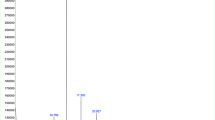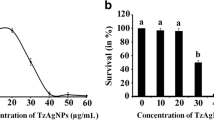Abstract
Urinary tract infections are the utmost common bacterial infections caused by Proteus mirabilis, Pseudomonas aeruginosa, Escherichia coli, and Serratia marcescens. These uropathogens resist the action of several antibiotics due to their ability to form biofilms. Most of these bacterial pathogens use the quorum sensing (QS) machinery to co-ordinate their cells and regulate several virulence factors and biofilm formation. On the other hand, the anti-quorum sensing (anti-QS) and antibiofilm potential of silver nanoparticles have been well reported against certain bacterial pathogens, but to the best of our knowledge, no report is available against the pathogenicity of uropathogens in particular S. marcescens and P. mirabilis. Therefore, the present study is primarily focused on the anti-QS and antibiofilm potential of Piper betle-based synthesized silver nanoparticles (PbAgNPs) against S. marcescens and P. mirabilis. Initially, the silver nanoparticles were synthesized by the aqueous extract of P. betle and characterized by UV-absorbance spectroscopy, XRD, FT-IR, SEM, TEM, and DLS. The synthesized silver nanoparticles were assessed for their anti-QS activity and the obtained results revealed that the PbAgNPs inhibited the QS-mediated virulence factors such as prodigiosin, protease, biofilm formation, exopolysaccharides and hydrophobicity productions in uropathogens. The gene expression analysis divulged the downregulation of fimA, fimC, flhD, and bsmB genes in S. marcescens and flhB, flhD, and rsbA genes in P. mirabilis, respectively. The in vivo Caenorhabditis elegans assays revealed the non-toxic and anti-adherence efficiency of PbAgNPs. Furthermore, the non-toxic effect of PbAgNPs was also confirmed through peripheral blood mononuclear cells and normal lung epithelial cells. Therefore, the contemporary study demonstrates the use of PbAgNPs as a possible alternative toward conventional antibiotics in controlling QS and biofilm-related uropathogen infections.








Similar content being viewed by others
References
Allison C, Emody L, Coleman N, Hughes C (1994) The role of swarm cell differentiation and multicellular migration in the uropathogenicity of Proteus mirabilis. J Infect Dis 169(5):1155–1158. https://doi.org/10.1093/infdis/169.5.1155
Bjarnsholt T, Givskov M (2008) Quorum sensing inhibitory drugs as next generation antimicrobials: worth the effort? Curr Infect Dis Rep 10(1):22–28. https://doi.org/10.1007/s11908-008-0006-y
BoraseHP, PatilCD, SauterIP, RottMB, PatilS V (2013) Amoebicidal activity of phytosynthesized silver nanoparticles and their in vitro cytotoxicity to human cells. FEMS Microbiol Lett. 345:127–131. https://doi.org/10.1111/1574-6968.12195
CLSI (2015) M07-A10: methods for dilution antimicrobial susceptibility tests for bacteria that grow aerobically; Approved Standard—Tenth Edition35:1–87
Costerton JW (1999) Bacterial bofilms: a common cause of persistent infections. Science (80- ) 284:1318–1322. https://doi.org/10.1126/science.284.5418.1318
Courtney HS, Ofek I, Penfound T, Nizet V, Pence MA, Kreikemeyer B, Podbielbski A, Hasty DL, Dale JB (2009) Relationship between expression of the family of M proteins and lipoteichoic acid to hydrophobicity and biofilm formation in Streptococcus pyogenes. PLoS One 4(1):e4166. https://doi.org/10.1371/journal.pone.0004166
Devi KR, Srinivasan R, Kannappan A, Santhakumari S, Bhuvaneswari M, Rajasekar P, Prabhu NM, Ravi AV (2016) In vitro and in vivo efficacy of rosmarinic acid on quorum sensing mediated biofilm formation and virulence factor production in Aeromonas hydrophila. Biofouling 32(10):1171–1183. https://doi.org/10.1080/08927014.2016.1237220
Favre-Bonté S, Köhler T, Van Delden C (2003) Biofilm formation by Pseudomonas aeruginosa: role of the C4-HSL cell-to-cell signal and inhibition by azithromycin. J Antimicrob Chemother 52(4):598–604. https://doi.org/10.1093/jac/dkg397
Gurunathan S, Jeong J-K, Han JW, Zhang X-F, Park JH, Kim J-H (2015) Multidimensional effects of biologically synthesized silver nanoparticles in Helicobacter pylori, Helicobacter felis, and human lung (L132) and lung carcinoma A549 cells. Nanoscale Res Lett 10(1):35. https://doi.org/10.1186/s11671-015-0747-0
Harris AKP, Williamson NR, Slater H, Cox A, Abbasi S, Foulds I, Simonsen HT, Leeper FJ, Salmond GP (2004) The Serratia gene cluster encoding biosynthesis of the red antibiotic, prodigiosin, shows species- and strain-dependent genome context variation. Microbiology 150(11):3547–3560. https://doi.org/10.1099/mic.0.27222-0
Hejazi A, Falkiner FR (1997) Serratia marcescens. J Med Microbiol 46(11):903–912. https://doi.org/10.1099/00222615-46-11-903
Hola V, Ruzicka F, Horka M (2010) Microbial diversity in biofilm infections of the urinary tract with the use of sonication techniques. FEMS Immunol Med Microbiol 59(3):525–528. https://doi.org/10.1111/j.1574-695X.2010.00703.x
Ilavarasi K, Kiruthiga PV, Pandian SK, Devi KP (2011) Hydroxytyrosol, the phenolic compound of olive oil protects human PBMC against oxidative stress and DNA damage mediated by 2,3,7,8-TCDD. Chemosphere 84(7):888–893. https://doi.org/10.1016/j.chemosphere.2011.06.017
Jadhav K, Dhamecha D, Bhattacharya D, Patil M (2016) Green and ecofriendly synthesis of silver nanoparticles: characterization, biocompatibility studies and gel formulation for treatment of infections in burns. J Photochem Photobiol B 155:109–115. https://doi.org/10.1016/j.jphotobiol.2016.01.002
Kamaladevi A, Balamurugan K (2015) Role of PMK-1/p38 MAPK defense in Caenorhabditis elegans against Klebsiella pneumoniae infection during host-pathogen interaction. Pathog Dis 73(5):ftv021. https://doi.org/10.1093/femspd/ftv021
Kannappan A, Gowrishankar S, Srinivasan R, Pandian SK, Ravi AV (2017a) Antibiofilm activity of Vetiveria zizanioides root extract against methicillin-resistant Staphylococcus aureus. Microb Pathog 110:313–324. https://doi.org/10.1016/j.micpath.2017.07.016
Kannappan A, Sivaranjani M, Srinivasan R, Rathna J, Pandian SK, Ravi AV (2017b) Inhibitory efficacy of geraniol on biofilm formation and development of adaptive resistance in Staphylococcus epidermidis RP62A. J Med Microbiol 66(10):1506–1515. https://doi.org/10.1099/jmm.0.000570
Kida Y, Inoue H, Shimizu T, Kuwano K (2007) Serratia marcescens serralysin induces inflammatory responses through protease-activated receptor 2. Infect Immun 75(1):164–174. https://doi.org/10.1128/IAI.01239-06
Kumar A, Worobec EA (2002) Fluoroquinolone resistance of Serratia marcescens: involvement of a proton gradient-dependent efflux pump. J Antimicrob Chemother 50(4):593–596. https://doi.org/10.1093/jac/dkf147
Kumar B, Smita K, Seqqat R, Benalcazar K, Grijalva M, Cumbal L (2016) In vitro evaluation of silver nanoparticles cytotoxicity on hepatic cancer (Hep-G2) cell line and their antioxidant activity: green approach for fabrication and application. J Photochem Photobiol B Biol 159:8–13. https://doi.org/10.1016/j.jphotobiol.2016.03.011
Labbate M, Queck SY, Koh KS, Rice SA, Givskov M, Kjelleberg S (2004) Quorum sensing-controlled biofilm development in Serratia liquefaciens MG1. J Bacteriol 186(3):692–698. https://doi.org/10.1128/JB.186.3.692-698.2004
Liaw SJ, Lai HC, Wang WB (2004) Modulation of swarming and virulence by fatty acids through the RsbA protein in Proteus mirabilis. Infect Immun 72(12):6836–6845. https://doi.org/10.1128/IAI.72.12.6836-6845.2004
Logeswari P, Silambarasan S, Abraham J (2013) Ecofriendly synthesis of silver nanoparticles from commercially available plant powders and their antibacterial properties. Sci Iran 20(3):1049–1054. https://doi.org/10.1016/j.scient.2013.05.016
Martinez-Gutierrez F, Boegli L, Agostinho A, Sánchez EM, Bach H, Ruiz F, James G (2013) Anti-biofilm activity of silver nanoparticles against different microorganisms. Biofouling 29(6):651–660. https://doi.org/10.1080/08927014.2013.794225
Mobley HLT, Belas R (1995) Swarming and pathogenicity of Proteus mirabilis in the urinary tract. Trends Microbiol 3(7):280–284. https://doi.org/10.1016/S0966-842X(00)88945-3
Mansouri S, Amari A, Asad AG (2005) Inhibitory effect of some medicinal plants from Iran on swarming motility of Proteus rods. J Med Sci 5(3):216–221
Morohoshi T, Tokita K, Ito S, Saito Y, Maeda S, Kato N, Ikeda T (2013) Inhibition of quorum sensing in gram-negative bacteria by alkylamine-modified cyclodextrins. J Biosci Bioeng 116(2):175–179. https://doi.org/10.1016/j.jbiosc.2013.01.022
Mulvaney P (1996) Surface plasmon spectroscopy of nanosized metal particles. Langmuir 12(3):788–800. https://doi.org/10.1021/la9502711
Musthafa KS, Saroja V, Pandian SK, Ravi AV (2011) Antipathogenic potential of marine bacillus sp. SS4 on N-acyl-homoserine- lactone-mediated virulence factors production in Pseudomonas aeruginosa (PAO1). J Biosci 36(1):55–67. https://doi.org/10.1007/s12038-011-9011-7
Palanisamy NK, Ferina N, Amirulhusni AN, Mohd-Zain Z, Hussaini J, Ping LJ, Durairaj R (2014) Antibiofilm properties of chemically synthesized silver nanoparticles found against Pseudomonas aeruginosa. J Nanobiotechnology 12(1):2. https://doi.org/10.1186/1477-3155-12-2
Pati R, Mehta RK, Mohanty S, Padhi A, Sengupta M, Vaseeharan B, Goswami C, Sonawane A (2014) Topical application of zinc oxide nanoparticles reduces bacterial skin infection in mice and exhibits antibacterial activity by inducing oxidative stress response and cell membrane disintegration in macrophages. Nanomedicine Nanotechnology, Biol Med 10(6):1195–1208. https://doi.org/10.1016/j.nano.2014.02.012
Pearson MM, Rasko DA, Smith SN, Mobley HLT (2010) Transcriptome of swarming Proteus mirabilis. Infect Immun 78(6):2834–2845. https://doi.org/10.1128/IAI.01222-09
Phan V, Belas R, Gilmore BF, Ceri H (2008) ZapA, a virulence factor in a rat model of Proteus mirabilis-induced acute and chronic prostatitis. Infect Immun 76(11):4859–4864. https://doi.org/10.1128/IAI.00122-08
Praba PS, Jeyasundari J, Arul YB (2014) Synthesis of silver Nano particles using Piper Betle and its antibacterial activity. Eur Chem Bull 3(10):1014–1016
Preethi R, Padma PR (2016) Green synthesis of silver nanobioconjugates from Piper betle leaves and its anticancer activity on A549 cells. Asian J Pharm Clin Res 9(1):252–257
Rai MK, Deshmukh SD, Ingle AP, Gade AK (2012) Silver nanoparticles: the powerful nanoweapon against multidrug-resistant bacteria. J Appl Microbiol 112(5):841–852. https://doi.org/10.1111/j.1365-2672.2012.05253.x
RamanathanS, RavindranD, ArunachalamK, ArumugamVR (2017) Inhibition of quorum sensing-dependent biofilm and virulence genes expression in environmental pathogen Serratia marcescens by petroselinic acid. Antonie Van Leeuwenhoek1–15. https://doi.org/10.1007/s10482-017-0971-y
Rasmussen TB, Givskov M (2006) Quorum sensing inhibitors: a bargain of effects. Microbiology 152(4):895–904. https://doi.org/10.1099/mic.0.28601-0
Sabbuba N, Hughes G, Stickler DJ (2002) The migration of Proteus mirabilis and other urinary tract pathogens over Foley catheters. BJU Int 89(1):55–60. https://doi.org/10.1046/j.1464-4096.2001.01721.x
Sahal G, Nasseri B, Bilkay IS, Piskin E (2015) Anti-biofilm effect of nanometer scale silver (NmSAg) coatings on glass and polystyrene surfaces against P. mirabilis, C. glabrata and C. tropicalis strains. J Appl Biomater Funct Mater 13(4):e351–e355. https://doi.org/10.5301/jabfm.5000248
Sathishkumar P, Preethi J, Vijayan R, Mohd Yusoff AR, Ameen F, Suresh S, Balagurunathan R, Palvannan T (2016) Anti-acne, anti-dandruff and anti-breast cancer efficacy of green synthesised silver nanoparticles using Coriandrum sativum leaf extract. J Photochem Photobiol B Biol 163:69–76. https://doi.org/10.1016/j.jphotobiol.2016.08.005
Schneider R, Lockatell CV, Johnson D, Belas R (2002) Detection and mutation of a luxS -encoded autoinducer in Proteus mirabilis. Microbiology 148(3):773–782. https://doi.org/10.1099/00221287-148-3-773
Singh BR, Singh BN, Singh A, Khan W, Naqvi AH, Singh HB (2015) Mycofabricated biosilver nanoparticles interrupt Pseudomonas aeruginosa quorum sensing systems. Sci Rep 5(1):13719. https://doi.org/10.1038/srep13719
Srinivasan R, Devi KR, Kannappan A, Pandian SK, Ravi AV (2016) Piper betle and its bioactive metabolite phytol mitigates quorum sensing mediated virulence factors and biofilm of nosocomial pathogen Serratia marcescensin vitro. J Ethnopharmacol 193:592–603. https://doi.org/10.1016/j.jep.2016.10.017
Srinivasan R, Santhakumari S, Ravi AV (2017) In vitro antibiofilm efficacy of Piper betle against quorum sensing mediated biofilm formation of luminescent Vibrio harveyi. Microb Pathog 110:232–239. https://doi.org/10.1016/j.micpath.2017.07.001
Soria C, Coccini T, De Simone U, Marchese L, Zorzoli I, Giorgetti S, Raimondi S, Mangione PP, Ramat S, Bellotti V, Manzo L, Stoppini M (2015) Enhanced toxicity of silver nanoparticles in transgenic Caenorhabditis elegans expressing amyloidogenic proteins. Amyloid 22(4):1–8. https://doi.org/10.3109/13506129.2015.1077216
Thomson NR, Crow MA, McGowan SJ, Cox A, Salmond GPC (2000) Biosynthesis of carbapenem antibiotic and prodigiosin pigment in Serratia is under quorum sensing control. Mol Microbiol 36(3):539–556. https://doi.org/10.1046/j.1365-2958.2000.01872.x
Trautner BW, Darouiche RO (2004) Role of biofilm in catheter-associated urinary tract infection. Am J Infect Control 32(3):177–183. https://doi.org/10.1016/j.ajic.2003.08.005
Wei JR, Lai HC (2006) N-Acylhomoserine lactone-dependent cell-to-cell communication and social behavior in the genus Serratia. Int J Med Microbiol 296(2–3):117–124. https://doi.org/10.1016/j.ijmm.2006.01.033
Acknowledgements
The authors thankfully acknowledge the computational and bioinformatics facility provided by the Alagappa University Bioinformatics Infrastructure Facility (Department of Biotechnology, Government of India; Grant no. BT/BI/25/015/2012 (BIF)). The author R. Srinivasan sincerely thanks the University Grants Commission, New Delhi, India, for the financial support in the form of UGC-BSR fellowship [F.4-1/2006(BSR)/7-326/2011(BSR)].
Author information
Authors and Affiliations
Corresponding author
Ethics declarations
Conflict of interest
The authors declare that they have no conflict of interest.
Additional information
Responsible editor: Philippe Garrigues
Electronic supplementary material
Rights and permissions
About this article
Cite this article
Srinivasan, R., Vigneshwari, L., Rajavel, T. et al. Biogenic synthesis of silver nanoparticles using Piper betle aqueous extract and evaluation of its anti-quorum sensing and antibiofilm potential against uropathogens with cytotoxic effects: an in vitro and in vivo approach. Environ Sci Pollut Res 25, 10538–10554 (2018). https://doi.org/10.1007/s11356-017-1049-0
Received:
Accepted:
Published:
Issue Date:
DOI: https://doi.org/10.1007/s11356-017-1049-0




